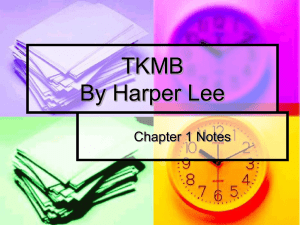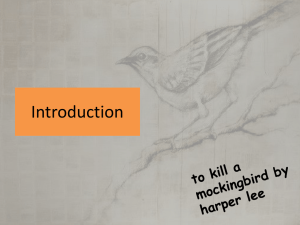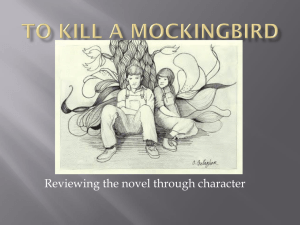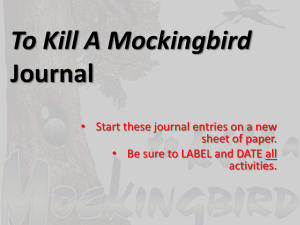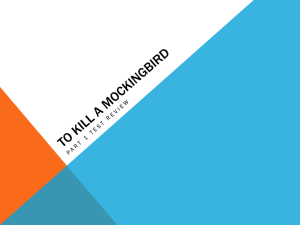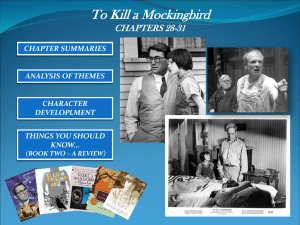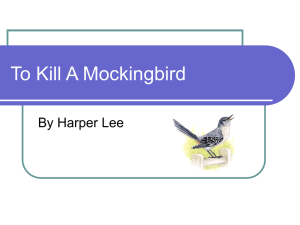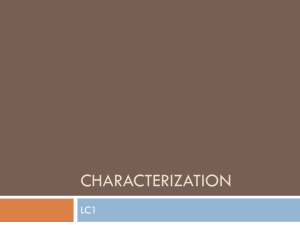To Kill a Mockingbird_Literary Terms_Week4 and 5Notes
advertisement
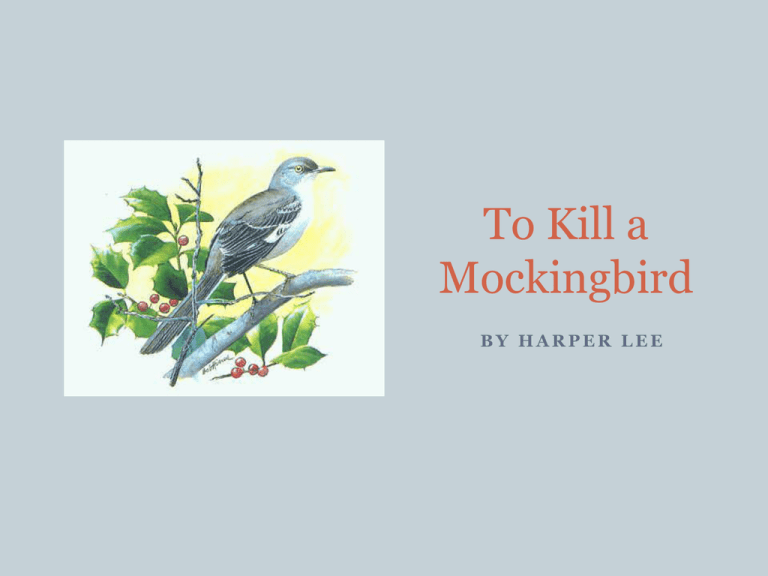
To Kill a Mockingbird BY HARPER LEE Historical Context and Setting Historical Context – Time period in history when a work take place Setting – The time and place where the action occurs The historical context plays an important role in the plot, setting and characters What decade is To Kill a Mockingbird set in? Important events What are some events that we discussed last week? Important people Who are some people we discussed last week? Life During the 1930s The Great Depression sweeps the nation – Many families do not even have money for basic needs such as food, clothing, and shelter. Hitler is Chancellor of Germany He believes that Jews, African Americans, and other races are inferior to AngloSaxons. The per capita income for families in Alabama (and Oklahoma) is $125 - $250 a year Franklin D. Roosevelt is President Legal Segregation Separate schools No interracial marriages Segregated water fountains Segregated theatres Setting The time and place where the action in the novel happens Maycomb, Alabama (fictional town) Small town in Alabama – All of the characters know one another 1933-1935 Theme Theme = topic + author’s opinion on the topic A Theme is the fundamental and often universal idea explored in a literary work. Topics for themes in To Kill a Mockingbird: Racial Prejudice Social Snobbery Morality Tolerance Patience Equality The Need for Compassion The Need for Conscience Characterization The way that an author uses descriptive language including dialogue to give a character personality traits in a text. Indirect characterization – When an author uses dialogue and actions to teach the reader something about the character. (Example: You learn through the characters speaking to one another that one of them is lying. Therefore, you judge that character is dishonest.) Direct characterization – When an author tells you about the character. (Example: The author tells you what the character looks like.) Characters in To Kill a Mockingbird Jean Louis Finch – “Scout” The story’s narrator Scout is six when the story begins She is naturally curious about life Jem Finch o Scout’s older brother o Looks up to his father Atticus o Usually looks out for Scout but the typical older brother at times o Smart and Compassionate o Matures as the story progresses o Direct characterization – “his left arm was somewhat shorter than his right...” More Characters... Atticus Finch Father of Scout and Jem A widower A highly-respected attorney by profession Instills good values and morals in his children Honest and Brave Typical southern gentleman Calpurnia The Finch’s black housekeeper and nanny A positive influence on the children Indirect Characterization – Calpurnia takes the children to her church where she interacts with other people. We learn she has good standing in the community and is well respected from her interactions. Motifs Motifs are recurring structures, contrasts, or literary devices that can help to develop and inform the text’s major themes Gothic Details Gothic refers to a style of fiction first popularized in eighteenth-century England, featuring supernatural occurrences, gloomy and haunted settings, full moons Small-Town Life Counterbalancing the Gothic motif of the story is the motif of old-fashioned, small-town values, which manifest themselves throughout the novel Tone and Mood Tone is set by the author’s word choice, use of motifs, and other literary devices – The author attitude towards the subject makes you feel a certain way....The author’s tone creates a... MOOD – The way the reader feels when reading the novel You know that Lee will use Gothic and Small-town motifs...what moods may be present due to this choice? Tones to look for in To Kill a Mockingbird Humorous (at times) Somber Serious Thought-provoking Moods that Harper Lee’s Tone Creates Child-like inquisitiveness Closeness of family ties Protective Suspenseful Community pride Embarrassment Anger Compassion Symbolism/Symbols Symbolism is when an author has a figurative meaning for a thing...it is literally a red rose, but it stands for love...and just any love...romantic love Common symbols Four-leaf clover White doves Olive branches Fire Water Ice Symbol – Mockingbird The title Atticus tells Scout, “Mockingbirds don’t do one thing but make music for us to enjoy. They don’t eat up people’s gardens, don’t nest in corncribs, they don’t do one thing but sing their hearts out for us. That’s why it’s a sin to kill a mockingbird.” In this story of innocents destroyed by evil, the “mockingbird” comes to represent the idea of innocence. Thus, to kill a mockingbird is to destroy innocence. Symbol – Boo Radley The children’s changing attitude toward Boo Radley is an important measurement of their development from innocence toward a grown-up moral perspective Pay attention to how they interact with Boo throughout the novel How does this symbol go hand in hand with the mockingbird symbol? Personification Literary element where an author gives human qualities to non-human things Example: The leaves danced in the wind. What is being personified? What human characteristic is the item given? Let’s practice! “Mr. Radley’s older son lived in Pensacola; he came home at Christmas, and he was one of the few people we ever saw enter or leave the place. From the day Mr. Radley took Arthur home, people say the house died” (Lee 12). Personification “The house was the same, droopy and sick, but as we stared down the street we thought we saw an inside shutter move. Flick. A tiny, almost invisible movement and the house was still” (Lee 15). Personification “There he was, returning to me. His white shirt bobbed over the back fence and slowly grew larger. He came up the back steps, latched the door behind him, and sat on his cot” (Lee 55). Personification Metaphor A figure of speech in which a term or phrase is applied to something to which it is not literally applicable in o rder to suggest a resemblance Example: “A mighty fortress is our God.” What 2 things are being compared? Why would the writer make this comparison? What is s/he trying to say? Let’s practice! “Then I heard Atticus cough. I held my breath. Sometimes when we made a midnight pilgrimage to the bathroom we would find him reading” (Lee 57). Metaphor “I knew when there was trouble in our street. Soft taffeta-like sounds and muffled scurrying sounds filled me with helpless dread” (Lee 69). Metaphor Simile A figure of speech where two unlike things are explicitly compared. The phrase uses “like” or “as” “She is like a rose.” What is being compared here? Let’s practice! “The Radley place fascinated Dill. In spite of our warnings it drew him as the moon draws water…” (Lee 8). Simile “Ladies bathed before noon, after their three-o’clock naps, and by nightfall were like soft teacakes with frostings of sweat and sweet talcum” (Lee 6). Simile Simile “It must have been two o’clock. The moon was setting and the lattice-work shadows were fading into fuzzy nothingness. Jem’s white shirt-tail dipped and bobbed like a small ghost dancing away to escape the coming morning” (Lee 57). Quick Discussion – Chapters 1 and 2 What does Dill dare Jem to do? What do the children think they see at the end of chapter 1? How does this add to suspense? How does the description of the Radleys home and family fit in to the gothic motif? Who is Miss Caroline Fisher? What is the problem with Walter Cunningham? Characterization – Chpts 1-5 Walter Cunningham and his family How does Scout describe Walter? What 2 events take place that give us insight into Walter’s home life? Hint: Miss Caroline Hint: Lunch with Calpurnia What does Scout tell us about her father’s interaction with the Cunninghams? How do you feel about the Cunningham family based on this instances in the novel? Characterization – Chpts 1-5 Burris Ewell and his family What are the Ewell’s reputation at school? What is Burris Ewell’s problem on the first day? What interaction does Burris have with Mis Caroline? How do you feel about Burris and his family based on the information presented already? Two Poor Depression-Era Families The Cunninghams The Ewells Poor white family Poor white trash Hard-working Dirty Honest Lazy Proud Good-for-nothing Survive on very little Never done a day’s work Always pay back their Foul-mouthed debts – even if it is with hickory nuts, turnips, or holly. Dishonest Immoral Preparing to Write – Mood Mood: The atmosphere that pervades a literary work with the intention of evoking a certain emotion or feeling from the audience. For example: The moods in a Edgar Allen Poe story, might be gloomy, horrific, or desperate. Mood is used to: create a feeling in the reader Show how the characters are feeling Foreshadow upcoming events in the text Test Review for Chapters 4 & 5 What does Scout find in the tree at the Radley house first? What do Scout and Jem find in the tree at the Radley house second? Who comes back to Macomb for the summer? How much time has gone by between chapter 1 and chapter 5? What does Scout hear inside the house at the end of Chapter 4? Who’s Miss Maudie? What do we find out about Arthur from Miss Maudie? How does Atticus react when he sees Jem and Scout playing the Boo Radley game? Characterization – Chpts 1-5 Walter Cunningham and his family How does Scout describe Walter? What 2 events take place that give us insight into Walter’s home life? Hint: Miss Caroline Hint: Lunch with Calpurnia What does Scout tell us about her father’s interaction with the Cunninghams? How do you feel about the Cunningham family based on this instances in the novel? Quick Discussion – Chapters 6-8 What happened in chapter 6? (Hint – We read it in class on Monday! Dill, Jem, & Scout had a close call...) What does Jem reveal about the night’s escapade in chapter 6 to Scout that he hadn’t revealed before? Why is this cause for concern for them? The tree yields 5 more gifts for Jem and Scout in Chapter 7 what are they? (f,m,g,w,t) What does Nathan Radley do to the tree? At the end of chapter 7 we are left wondering who left the gifts, but we have a solid clue that leads us to believe it’s someone....who? And what is the clue? Quick Discussion – Chapters 6-8 In chapter 8, what happens that hasn’t happened in a long time in Maycomb? What happens to Miss Maudie’s barn? Why do you think the author added this happening? Who gives Scout the blanket? Why is this significant? Get ready for a change! At this point in the novel, the focus goes from Boo Radley and the children to Atticus and his court case! Let’s prepare to read Chapter 9-10 Characterization: Atticus Think about our background information...The Scottsboro case, the segregation, the accepted racism, the time period of the 1930s in southern states. Consider the character Atticus – He’s a lawyer. What kind of person is he based on what we have seen so far? What does he believe in? “Do you know what a compromise is?...an agreement reached by mutual concessions...” “I’m going to tell you something and tell you one time: Quit tormenting that man.” “You never really understand a person until you consider things from his point of view….” Preparing to Read Chapters 9-10 The Black Community in Maycomb, AL Simple Honest Clean Hard-working God fearing Proud Would never take anything with paying it back Respectful Oppressed Uneducated Discriminated against Talked about badly Deserve better than what is dished out to them by society Preparing to Read Chapter 11 Morphine: A Southern Lady’s Drug 1930s Typical Morphine Addict: White female Middle-aged or older Widowed Homebound Lives in the south Property owner Began using morphine for medical reasons (pain relief) In “To Kill a Mockingbird,” the Finch children will become acquainted with a morphine addict named Mrs. Dubose. Although only a fictitious character, she personifies the American morphine addict of the late nineteenth and early twentieth centuries. Chapter 13 and 14 Quick Review Why all of the talk about family “history?” Aunt Alexandria’s take on teaching Jem and Scout their history Atticus’ take on teaching the kids their history Why does Aunt Alexandria want to get rid of Calpurnia? Jem is trying to “teach” Scout something about Atticus – What is it? Pg 138 How does this show he Is growing up? What is under Scout’s bed? What is Dill’s point about his parents? pg143 Quick Quiz – Chapter 17 What does Heck Tate tell the jury about Mayella’s injuries? 1. 1. 2. 2. 3. 4. 5. 6. 7. 8. 9. Where was she injured? How severe were the injuries? Who is Bob Ewell? Briefly describe the Ewell family home. Why does the judge keep giving Mr. Ewell cautioning looks as he’s giving his testimony? Why does Reverend Sykes tell Jem to take Scout out of the courtroom? Is it ironic that Mr. Ewell says that the black community is “devaluin’ my property”? Why or why not? Why does Mr. Ewell say he didn’t send for a doctor for Mayella? Why does Atticus confirm that Mr. Ewell agrees with Mr. Tate’s testimony? What do we find out about Mr. Ewell on the last page of the chapter and why is this important? Quick Quiz – Chapter 18-20 1. 2. 3. 4. 5. 6. 7. 8. The narrator (Scout) says that Mayella is like a cat with a twitching tail when she takes the stand. Why do you think she compares her to this animal? At the end of chapter 18, we see that Tom could not have possibly committed the crime. How do we know? How many times had Tom Robinson been to Mayella’s home and why did he go? How does Tom say Mayella got the kids to leave the house on the day in question? What does Tom say Mayella did to him when he came inside the house? What does Tom say that Bob Ewell said when he saw Mayella with him? (paraphrase your answer) What was Tom convicted of previously and why does Mr. Gilmer bring up this point? Who talks to Dolphus Raymond? Quick Quiz – Chapter 18-20 Continued 1. What do we learn about Dolphus Raymond’s drinking habit? Will Justice Be Served? We’ll start reading on page 203 so get ready..First, let’s review what we already know about the case… Who is being accused? Who is the accuser? What is he accused of? Who is the prosecutor? Who is opposing counsel? Who choose the jury? Who has testified? Who do we believe? What side do you think the Jury is on? What side do you guess the judge is on? What side are you on?! Themes – Let’s revisit… Theme = topic + author’s opinion on the topic A Theme is the fundamental and often universal idea explored in a literary work. Topics for themes in To Kill a Mockingbird: Racial Prejudice Social Snobbery Morality Tolerance Patience Equality The Need for Compassion The Need for Conscience Motif - Let’s revisit… Motifs are recurring structures, contrasts, or literary devices that can help to develop and inform the text’s major themes Gothic Details Gothic refers to a style of fiction first popularized in eighteenth-century England, featuring supernatural occurrences, gloomy and haunted settings, full moons Small-Town Life Counterbalancing the Gothic motif of the story is the motif of old-fashioned, small-town values, which manifest themselves throughout the novel To think about for your essay… • • • How does the mood set by the author support a theme in the novel? How does a motif in the novel help create a mood for the reader? These are questions that you will want to answer as a part of your paper! You guessed it! POP QUIZ Chapters 24-27 1. 2. 3. 4. 5. 6. Why does Atticus interrupt the mission society luncheon? What does Bob Ewell mean when he says, “one down and about two more to go?” True or False – Atticus gets reelected to the state legislature. Chapter 26 highlights a severe case of hypocrisy. It has to do with Scout’s teacher – Miss Gates and Hitler...did you catch it? If you did, I will be SO PROUD OF YOU and give you credit for this question. Please tell me what Scout figures out about Miss Gates. According to Scout 3 things “out of the ordinary” happened in Maycomb. What are they? (3 points) What is the next holiday and what is going to happen to celebrate? (hmmm, I see another example of motif being demonstrated here...) You’re Last Pop Quiz (for TKaM)! 1. 2. 3. 4. 5. 6. Who tries to kill Scout and Jem? Who saves Scout and Jem? Why does Atticus have the conversations with Boo, Sherriff Tate, and the children out on the porch? Who does Atticus think kills Bob Ewell? Who actually kills Bob Ewell? Why does the knife that killed Bob prove that Jem did not do it? Let’s read a couple passages from the very end… • Character Development • Atticus is deeply respected in the community and he deserves respect….WHY? • Let’s read page 273 and think about what this means about Atticus’ personality • Does Atticus have a strong character arc? Just a bit more… • Character Development – pg 278 • Jem changes from beginning of the story • How does he start? • Attitude towards Atticus • Attitude towards Boo Radley • How does he end? • Scout changes from beginning to end • How does she start? • Attitude towards Calpurnia & Aunt Alexandria • Attitude towards Boo Radley • How does she end? Symbol – Mockingbird The title Atticus tells Scout, “Mockingbirds don’t do one thing but make music for us to enjoy. They don’t eat up people’s gardens, don’t nest in corncribs, they don’t do one thing but sing their hearts out for us. That’s why it’s a sin to kill a mockingbird.” In this story of innocents destroyed by evil, the “mockingbird” comes to represent the idea of innocence. Thus, to kill a mockingbird is to destroy innocence. Who are our mockingbirds? Symbol – Boo Radley The children’s changing attitude toward Boo Radley is an important measurement of their development from innocence toward a grown-up moral perspective At the beginning the children see Boo as.... At the end the children see Boo as... How does this symbol go hand in hand with the mockingbird symbol? Our Final Due Dates for this Unit Monday, March 11 – Rough Draft of your essay due Monday, March 11 – Counseling registration form due Monday, March 11 – CAHSEE review Tuesday/Wednesday, March 12-13 – CAHSEE Thursday, March 14 – get your rough draft back Friday March 15 – Final draft of your essay due, To Kill a Mockingbird Yearbook due, TKaM Packet due BUSY, BUSY, BUSY...don’t waste time these next few days!
